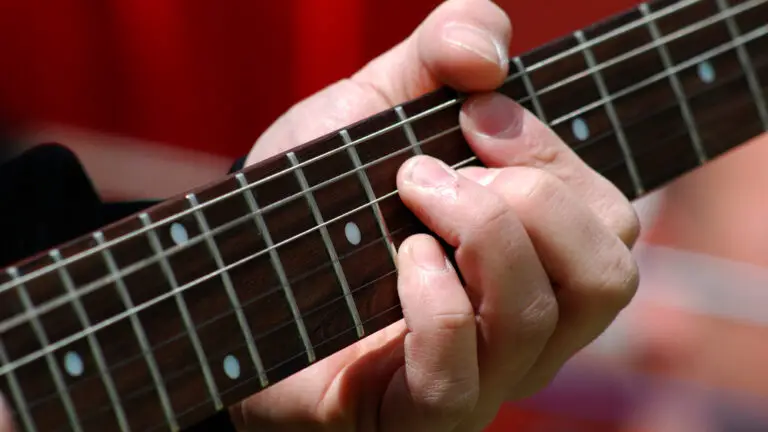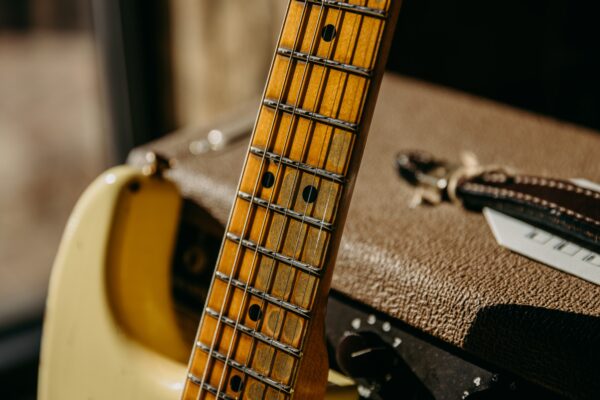Table of Contents
Becoming a great guitar player does not only require learning scales and knowing how to play fast solos, you also need to know how to take care of your hands. Using the right techniques and approach can help make your guitar learning process easier and faster if you know the right tips.
In this guide, we’ll explain exactly how you should take care of your hands to play guitar and give you 9 tips to help you.
How to prepare your hands to play guitar
While this is often an overlooked topic, preparing your hands for guitar is an important step to take even before you start playing. Especially if you are just starting to learn how to play. Always start by stretching your hands slightly, and when you pick up the guitar, start with simple exercises at first. This will warm up your hands to play more complicated melodies and harmonies later in your practice session.
Warm-up guitar exercises can help you improve your dexterity, strength, coordination, and technique while preparing your fingers for longer practice sessions.
How to toughen your hands to play guitar
Toughening your hands to play guitar includes training your hand muscles as well as developing your guitar calluses, and it can only be achieved by constantly practicing and grip-strengthening exercises.
You can also use squeezing a ball, for example, to improve your strength, and flexing your fingers and wrist can also help you strengthen your hand muscles and improve your coordination and dexterity. Additionally, practicing chords with greater intensity or holding notes longer than usual can help build up the strength of one’s hands over time.
9 Tips to take care of your hands for guitar
Here are a few of our most important tips to take care of your hands for guitar:
1. Warm up your hands before playing
Warming up your hands before playing guitar will help you prepare your muscles, tendons, and joints for playing. Just like you would warm up before exercising, warming up your hands can help prevent injuries and improve your overall performance.
It will also help you toughen your hands and prevent any soreness or pain after playing for long periods of time. Start with simple and slow warm-up exercises and gradually increase the speed.
2. Give your fingers time to rest
Resting is as important as playing, and it is the only way to develop your guitar skills. Think of a bodybuilder that works every single day and all the time. Obviously, the muscles will always be sore and fatigued. When you are playing guitar, you should take a similar approach, and therefore you need to give your fingers time to rest and take breaks.
3. Do not push yourself too hard
Another common mistake beginners make is that they push themselves too hard, and this might end up with soreness in the fingers and guitar blisters which end up delaying their learning process. Remember always to give yourself time to rest and practice regularly, even if that means practicing for fewer hours. At the end of the day, it is better to practice for one hour every day than to practice for 3 hours, leaving your hands and fingers fatigued and sore.
4. Give your calluses time to form
Guitar calluses take time to form, and until they start forming, it will be rather painful to play for extended periods of time. Therefore, it is important to give your hands and fingers time to rest while your guitar calluses are still forming. This will prevent you from getting guitar blisters and delaying your learning process.
5. Use cream
Using hand cream after a practice session is another great tip. This will help moisturize your hands while repairing the skin tissue on your fingertips. It is one of the most important things guitar players can do to maintain the strength and hardness of their calluses.
6. Use the right guitar pick
Not every guitar pick is the same, and the different pick models serve different purposes and are more suitable for different styles of music, techniques, and so on. Additionally, each guitar player has a preference for certain picks, and choosing a pick that you are comfortable with will help you to play better and to prevent any pain or discomfort.
7. Trim your nails
Your nails can easily get in the way of playing, at least the ones on your fretboard hand! This is why it is important to get your nails trimmed, so they do not start hitting the fretboard and making it more difficult for you to play certain notes and chords.
8. Use a guitar you are comfortable with
Finally, using a guitar that you are comfortable with is an important tip to consider. This means that you should consider the correct string gauge, guitar neck size, and guitar body. For example, if you are still a beginner, you should use light gauge strings because they are easier to press and make it easier to learn and play.
Moreover, choosing a guitar with the correct neck size is also extremely important. Since not all of us have the same hands, different necks will impact each player differently. For example, a guitarist with small hands will prefer a guitar neck that is thinner, and makes it easier to reach all of the notes. A guitar player with larger hands might prefer a chunkier guitar neck.
Finally, the guitar body can also make it easier or more difficult for your hands when you are playing guitar. If you have smaller arms, you should choose a guitar with a smaller body.
Does playing guitar damage your fingers?
While playing guitar alone doesn’t damage your fingers, playing for extended periods of time without taking care of your hands can damage your fingers. This is why it is crucial to be cautious when practicing guitar, so you do not damage your fingers and slow down your learning progress.
Remember that playing guitar is just like exercising, and if you do not do it correctly and follow all the recommended procedures, you may damage your hands and fingers. This will only delay your learning and improvement process.
Guitarist Hand Care FAQ
How long does it take for your hands to get used to playing guitar?
Depending on the guitar player and how much they are practicing, it can take from 3 to 6 months for your hands to get used to playing guitar. Remember that playing guitar is a very unnatural movement for both your hands and your own body, and for that reason, it takes a long time for you to get used to it.
How long does it take to build hand strength to play guitar?
Usually, it takes around a month to build the required hand strength to play guitar, which may vary depending on your current hand strength and how many hours you are practicing. Additionally, you should also consider hand strength exercises which tend to be a great way to prepare your hands to play guitar and also prevents injuries, soreness and discomfort.
Do you have to build calluses to play guitar?
Yes, to play guitar over extended periods, you need to have guitar calluses. This is because the constant friction of the metal string between your fingertip and the guitar fretboard slowly damages the skin on your fingertips. Therefore, if you do not have guitar calluses, it will be extremely painful to play for long periods. Guitar calluses also take a few months to form fully, so during that time, you want to avoid playing for extended periods.
Should you moisturize your hands before playing guitar?
No, you should avoid moisturizing your hands before playing guitar because the moisturizer residue will sit on your guitar strings and fretboard. Moreover, guitar players should use a moisturizer to repair their skin at the end of a practice session. This will help your skin repair and toughen up for the next practice.

I have been playing guitar for the past 15 years, and my knowledge and passion for guitars prompted me to start Guitaresque to share my knowledge, tips, and tricks with other guitar players. The sole purpose of this website is to help and inspire guitar players worldwide, to improve their playing and their love for guitars.









